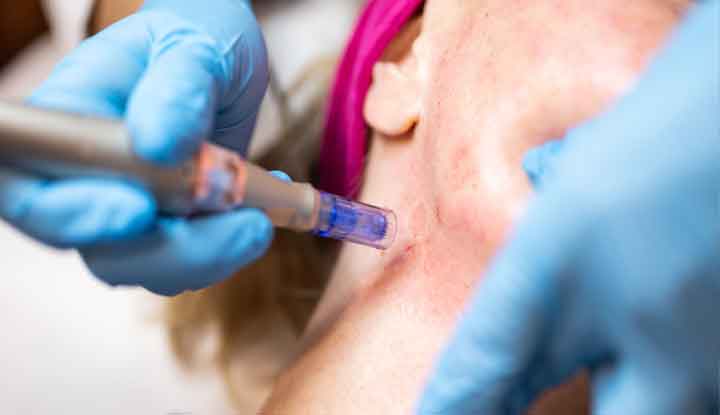
New service: Microneedling with SkinPen
What is Microneedling?

Most people get microneedling on their face and neck, but you can also get it on your legs, back or other areas where you notice damaged or aging skin. You’ll probably need multiple treatments to achieve your desired results.
Who would benefit from Microneedling?
You might consider microneedling if you’re concerned about:
- Enlarged pores.
- Fine lines or wrinkles.
- Loose or crepey (thin and wrinkled) skin.
- Mild scars, especially those from acne or burns.
- Skin discoloration or uneven skin tone.
- Stretch marks.
Who shouldn’t have microneedling?
Talk to your healthcare provider before getting microneedling if you have:
- Acne or are taking medication for acne.
- Blood disorders or are on anticoagulants (drugs that prevent blood clots).
- Cancer and are receiving chemotherapy or radiation therapy.
- Frequent skin rashes or cold sores.
- Tendency to form Keloid scarring
- Moles, freckles, skin tags or other growths that change in size or shape or bleed.
- Skin conditions such as eczema or psoriasis.
What happens during microneedling?
Your healthcare provider cleans your skin and applies a numbing cream. They do this about 20 to 30 minutes before your procedure, so the ointment has time to work.
Next, your provider uses an electric tool to make the wounds in your skin. The electric device has small needles that pulse up and down to puncture your skin. The length of the needles on the electric device can be adjusted. Longer needles go deeper into your skin, which might be necessary if you have deep scars or pockmarks from acne. Needle lengths can range from 0.5 millimeters to 2 millimeters.
You might feel warmth or a scratching sensation on your face once the microneedling starts. Some people feel discomfort if the needles are near bony areas, such as your cheekbones. Deep microneedling might cause a little bleeding.
The procedure usually takes 10-20 minutes, depending on how big the area is. Most people need 3-6 treatments to see a difference.
What happens after microneedling?
Microneedling is an outpatient procedure, so you can go home once it’s done. Your skin might be red and swollen for up to five days. An ice pack can help reduce irritation and discomfort. Most people can wear makeup the day after the procedure, but you should stay out of the sun until your skin heals.
What can I expect after microneedling?
In the days and weeks after microneedling, you might notice that your skin burns or feels tight. Some people also have dry, flaking skin that improves with moisturizer.
Most people need multiple microneedling treatments, usually about 3 weeks to 8 weeks apart. It can take 3 months to 6 months to see results. Afterward, you might need the procedure once a year for maintenance.
What are the benefits of microneedling?
Microneedling can help improve the appearance and texture of your skin. It can minimize stretch marks, scars, wrinkles and other skin concerns.
It doesn’t carry the risk of skin discoloration, unlike some facial rejuvenation procedures that use heat, light or lasers. This makes microneedling ideal for people with darker skin tones.
What are the risks of microneedling?
Microneedling is a safe procedure, but risks may include:
- Bruising.
- Scarring.
- Skin infection.
When should I see my healthcare provider?
Contact your healthcare provider if you notice the treated area is:
- Bleeding for longer than 24 hours.
- Blistered.
- Swollen for longer than a week.
What should I ask my healthcare provider about microneedling?
You may want to ask your healthcare provider:
- Am I a good candidate for microneedling?
- Can I perform microneedling at home?
- Would another treatment, such as microdermabrasion or a chemical peel, work better for me?
Resources:
https://my.clevelandclinic.org/health/treatments/23113-microneedling

